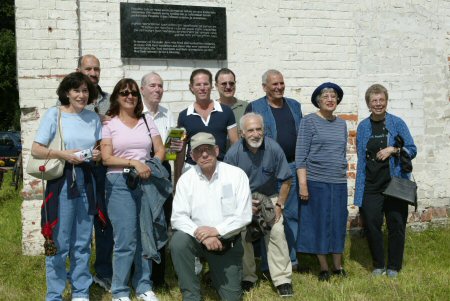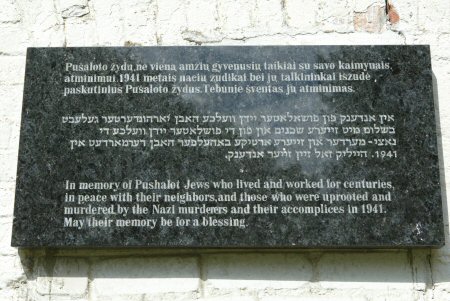Pusalotas Synagogue Dedication Ceremony
by Gilda Kurtzman
The Day the Jews Returned to their Shtetl

From Left to Right - Helene Stein Musikanth, Brian Stein, Robyn Stein, Howard Margol, Gary Margol, Larry Frank (kneeling), Aaron Roetenberg, Edward Powell, Reuven Brog, Gilda Kurtzman, Marilyn Frank Lerman
On July 3, 2005, over 200 years since the first Jews settled in the small hamlet of Pusalotas, Lithuania, and over 60 years after its last Jewish residents were slaughtered by the Nazis, eleven descendents returned to the shtetl to pay tribute to Holocaust victims and to mark the restoration of the town's 150-year-old Jewish cemetery.
This emotional gathering was the highlight of one year of activity which united Pushelot descendants for the first time, resulting in the launch of two major projects. It all began last summer when I suggested to fellow-Pusalotas descendant Howard Margol, an expert on Lithuanian genealogy and the most active researcher of Pusalotas, the creation of a Special Interest Group e-mail list for Pusalotas researchers. With Howard's enthusiastic endorsement and the help of Micha Reisel, we set up the group with an initial membership of around 50 names. Today the list has grown to 106.
Roots Tour - September, 2004
Last September my husband Bob and I went on a roots tour to Lithuania. A major destination was Pusalotas, the birthplace of my grandfather, Philip Sherman, and my great-grandparents Kasriel and Rashe Slott Sherman. When we reached the town's Jewish cemetery, miraculously spared the destruction of so many Lithuanian cemeteries at the hands of the Russians, I even found the grave of Rashe Slott’s father, Macy Meisel Zlot. I was moved to tears when I placed a stone on this precious stone, yet I was appalled at the neglected condition of the surrounding cemetery. I asked our guide, Yulik Gurevich, about the feasibility of cleaning and restoring the cemetery, including taking "rubbings" of the tombstones, photographing them, and organizing the data on the graves for use by Pusalotas researchers. The fee he suggested for the project seemed reasonable to both Howard and me. To raise the funds, we turned to everyone on our e-mail list as well as other family members to inform them of the restoration efforts and solicit donations. The response was overwhelming. Donations were received from across the globe, enabling us to retain Yulik Gurevich's services for the following spring, when the weather would permit the painstaking work to begin.
In January 2005, we capitalized on Yulik Gurevich's visit to Israel to organize the first-ever gathering of Israeli Pusalotas Descendents. Dina Schwartz graciously opened her home in Givatayim to host participants who came from across the nation. The attendees were young and old alike, natives of Europe, the former USSR, South Africa, Australia, North America and Israel. In addition to the opportunity to socialize, the Pusalotas descendants had the rare treat of learning more about their families, particularly from very young 94-year-old Yehudit Zaks who remembered someone from almost every family represented at the meeting. Yulik spoke to the group about the history of the town and area, and gave details of the upcoming cemetery restoration project. We solicited donations from the Israeli descendents, and again the response was far beyond our expectations.
At this point I came up with the idea to extend the goals of the Cemetery Restoration Fund to include the erecting of a fence around the premises. The cemetery, which borders on a small farm, is constantly desecrated by the many animals who wander there freely. Yulik explored the cost of purchasing the fencing material and hiring a local crew to carry out the labor. His resulting estimates were within our budget, and we gave him the green light. The descendants were all informed of our progress, as our shared excitement began to grow and grow.
Donations continued to pour in, much to our delight. My next idea was to put up a plaque memorializing the Jews murdered in the Holocaust. By present Lithuanian law, a monument must be placed at the entrance of every cemetery. However, since most of the Jews of Pusalotas were rounded up to be murdered in the nearby Panevezys forest, there is no memorial for them in the town. We thus decided to create a memorial plaque, in Lithuanian and English, to be affixed to the former synagogue building which still stands on Pusalotas' main street.
In January, Howard Margol publicized the 12th tour he'd be leading to Lithuania, scheduled for July. When a number of Pusalotas descendents registered, I suggested that there be a ceremony during the tour to dedicate the newly renovated cemetery and the plaque. Plans were then finalized, with invitations to the event extended to various Lithuanian dignitaries, Jewish and non-Jewish. The mayor of the town, Mrs. Stavinskiene, cooperated with us in every aspect of the project, pleased that the work would bring welcome employment and income to some of the town's residents.
Meanwhile, thanks to the increased communication among the “Pusalotas Descendants List" and their immediate relatives, a second major project was launched. While researching my own extended family, I'd realized that many relatives had married into other families in Pusalotas. The town's Jewish population at the end of the 19th century numbered 920 out of a total of 1,200 residents. To test my growing hypothesis that the entire shtetl was somehow connected, I put out a call to other descendants to send me their family trees. Using sophisticated software, I was able to take the 25 trees I received and merge them to create the initial master Family Tree of the Jewish Families of Pusalotas. The results were conclusive--out of the 25 family trees, 20 of them included "overlapping" ancestors from other Pusalotas families. If the shtetl's residents were not directly related to each other, they were at least connected. The resulting Tree, containing over 11,000 names, is a work in progress which I plan to update as often as possible. I prepared copies of the database to present to the Jewish Museum in Vilna, the Jewish Museum in Panevezys, the Pasvalys Musem, and the Lithuanian State Historical Archives and chose the dedication ceremony in Pusalotas to present the first copy of this master Family Tree to the Town of Pusalotas.
On July 3, 2005, eleven descendants of the town gathered at the site of the former synagogue in Pusalotas, today a textile mill. To our surprise, we saw that Mayor Stavinskiene had invited the townspeople, who came out in large numbers to honor our ancestors. Also in attendance were the director of the Pasvalys Museum which has a Jewish section, Ms. Galina Baranova, the chief archivist of the Lithuanian State Historical Archives, Mr. Milan Chersonskij, the editor of the newspaper “Jerusalem of Lithuania” and the representative of the JOINT in Lithuania.
Howard Margol was the main speaker. Mayor Stavinskiene then presented him with a gift, commenting how impressive it was for the Jewish people come back to honor their ancestors, since the Lithuanians do not have such a tradition. I joined Panevezys Jewish community head Mr. Genady Koifman and a Lithuanian Jewish organization head Rabbi Feffer in giving greetings, with Yulik translating all proceedings into English or Lithuanian. Mayor Stavinskiene had also arranged for the town choir to sing two Lithuanian folk songs, providing a charming touch.
After the very impressive plaque was unveiled, we walked from the synagogue to the cemetery where the Yizkor prayer was recited. The grounds had been cleaned up very nicely, a welcome contrast to the cemetery's previously neglected state. Several people found the tombstones of their ancestors. Other stones were not readable in their present state, but they have been rubbed and will be included in the database to be completed in the near future. This record will be forwarded to all those who donated to the Fund and had such a major part in making this very emotional and exciting day come about.
Today's descendents of Pusalotas may be spread all over the world, but part of our hearts still remain in this small shtetl where our ancestors put down roots for a short period of Jewish history. Thankfully we have been given the privilege to honor and sustain their blessed memories.
About the Writer
Gilda Kurtzman has been researching her families in Lithuanian since for about eight years. She can trace two of them back to approximately 1750 encompassing eleven generations. She is involved in several genealogical activities, mainly translating/transliterating cemetery databases for JewishGen (JOWBR) and the ongoing projects in Pusalotas.
Photos:

The plaque

Howard and Gary Margol at the plaque after the unveiling
The new fence at the Pusalotas cemetery
The new fence at the Pusalotas cemetery
The new fence at the Pusalotas cemetery
The new fence at the Pusalotas cemetery
- Home
- History of Pushelat
- Photo Album
- The Life and Death of a Shtetl
- Murder in Pushelat – The Ehud Barak Connection
- My Story - Pushelat during WWI
- List of those who Perished
- Pushelat Cemetery
- Roots Tours
- Interesting articles
- Those who perished 1941
- Pusalotas Families
- Research & Travel in Lithuania
- Pushelat arrivals in S. Africa
- Rachel Sharfstein Memoirs
- Mary Herr Bernhard Memoirs
- Pusalotas Gang of Thieves
- A Genealogical Odyssey
- Synagogue Dedication
- Contact Us

